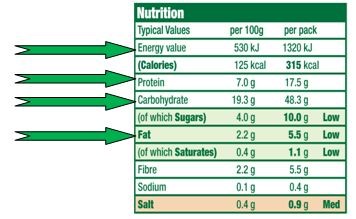We are constantly told how much sugar there is in fizzy drinks and cakes. But what about the hidden sugar in so-called healthy foods?
It’s easy to find this ‘hidden sugar’ in the food you eat by following these fairly simple steps.
• Look at the “Carbohydrate (of which sugars)” on the nutrition panel – this includes both natural and added sugars; less than 5g per 100g is low, while more than 22.5g per 100g is high.


• Check the ingredients list for anything ending in ‘ose’ (glucose, sucrose, fructose, lactose, maltose) – these are all forms of sugar, as are honey, agave, molasses and syrups like corn and rice syrup. The higher up the ingredients list these are, the more sugar the product contains.
How much should I be eating?
There are two types of sugar – naturally occurring sugar like lactose in milk and added, or ‘free’ sugars, which include table sugar (sucrose) as well as concentrated sources like fruit juice. It is these ‘free sugars’ which are any sugars added to food or drinks, or found naturally in honey, syrups and unsweetened fruit juices which we are being advised to cut back on.
The new recommendations from the World Health Organisation (WHO) and the UK’s official nutrition advisers are that only 5% of your daily calorie intake should consist of added, or ‘free’ sugars. This equates to approximately seven sugar cubes (30g).
Ways to cut down on your sugar intake
Making a few adjustments to your diet can help you cut down on unnecessary sugar consumption and avoid these ‘hidden sugars’.
• Reduce the sugar you add to hot drinks. Do so gradually to give your taste buds time to adjust. Try adding a sprinkle of cinnamon, cinnamon helps stabilise blood sugar levels and adds flavour without the sweetness.
• Avoid low-fat ‘diet’ foods which tend to be high in sugars. Instead have smaller portions of the regular versions.
• Be wary of ‘sugar-free’ foods. These often contain synthetic sweeteners like sucralose, saccharin and aspartame. Although these taste sweet, they don’t help curb a sweet tooth so they tend to send confusing messages to the brain, which can lead to over-eating.
• Balance your carb intake with lean protein like fish, chicken and turkey – protein foods slow stomach emptying, which helps manage cravings.
• Swap white bread, rice and pasta for wholegrain versions like oats, granary and wholemeal breads, brown rice and pasta.
• Reduce the sugar in recipes and add spices to boost flavour and taste.
• Stick to one glass of fruit juice a day (and dilute it) and keep sweet soft drinks and alcohol for the weekends. Enjoy herbal teas or water with slices of citrus fruits for flavouring.
• For a pick-me-up, have a piece of whole fruit with a handful of nuts or a small tub of plain yogurt. Both contain protein which helps balance blood sugar and energy levels.